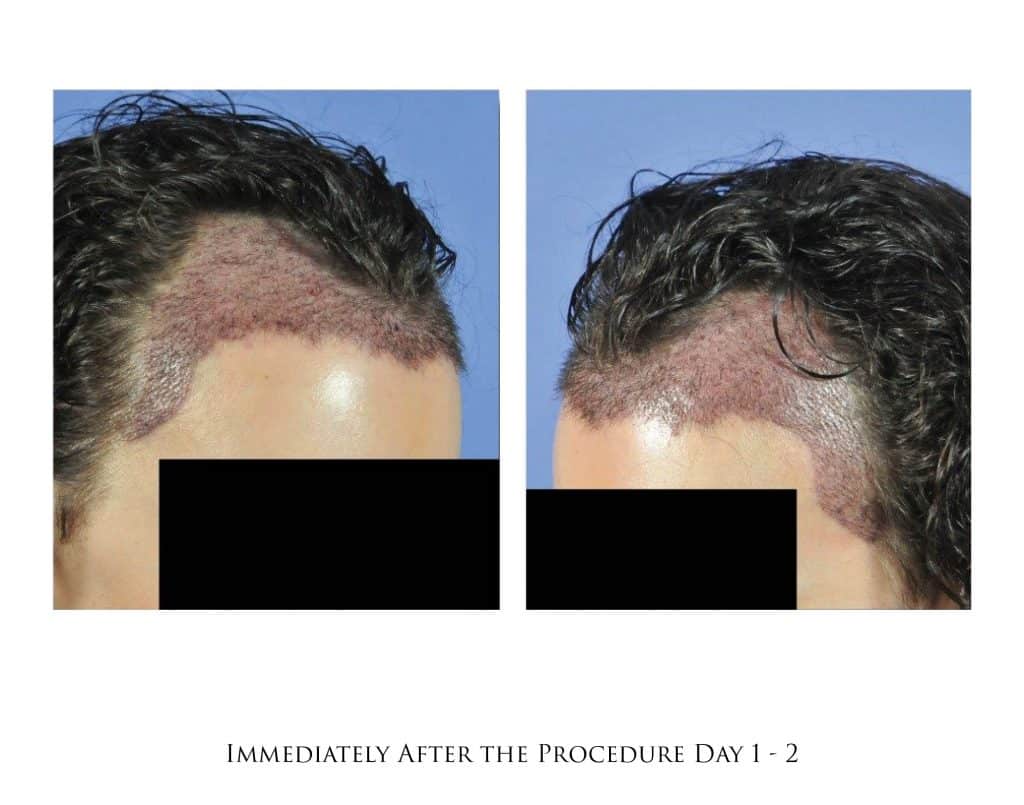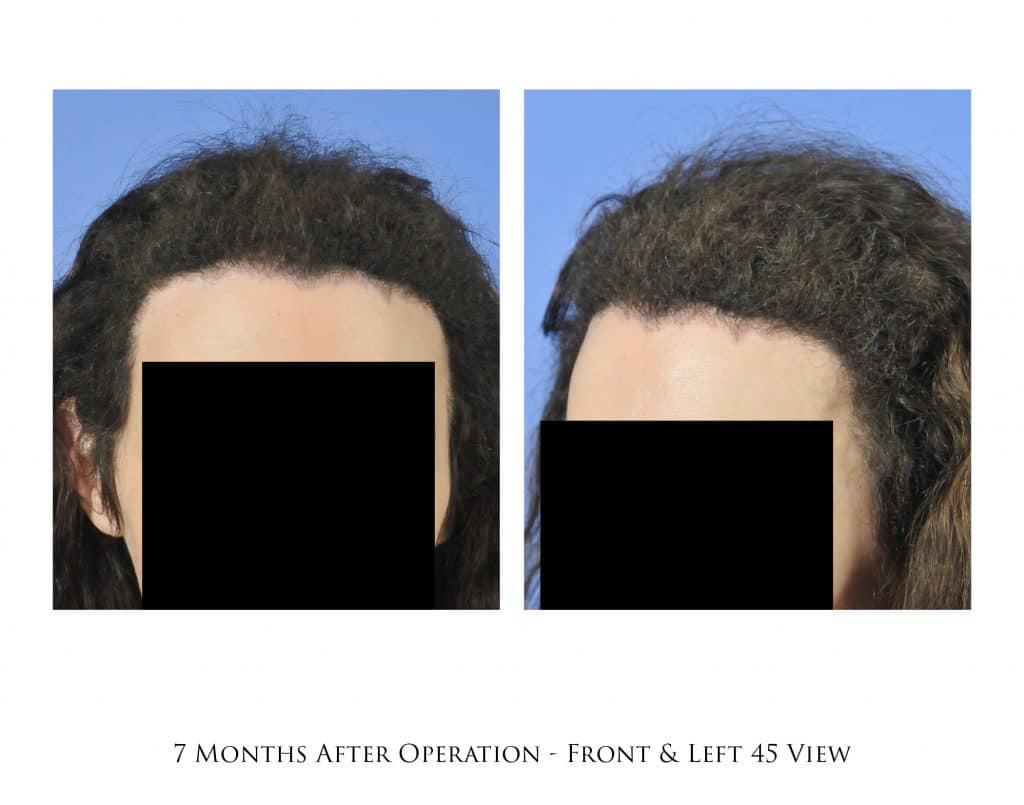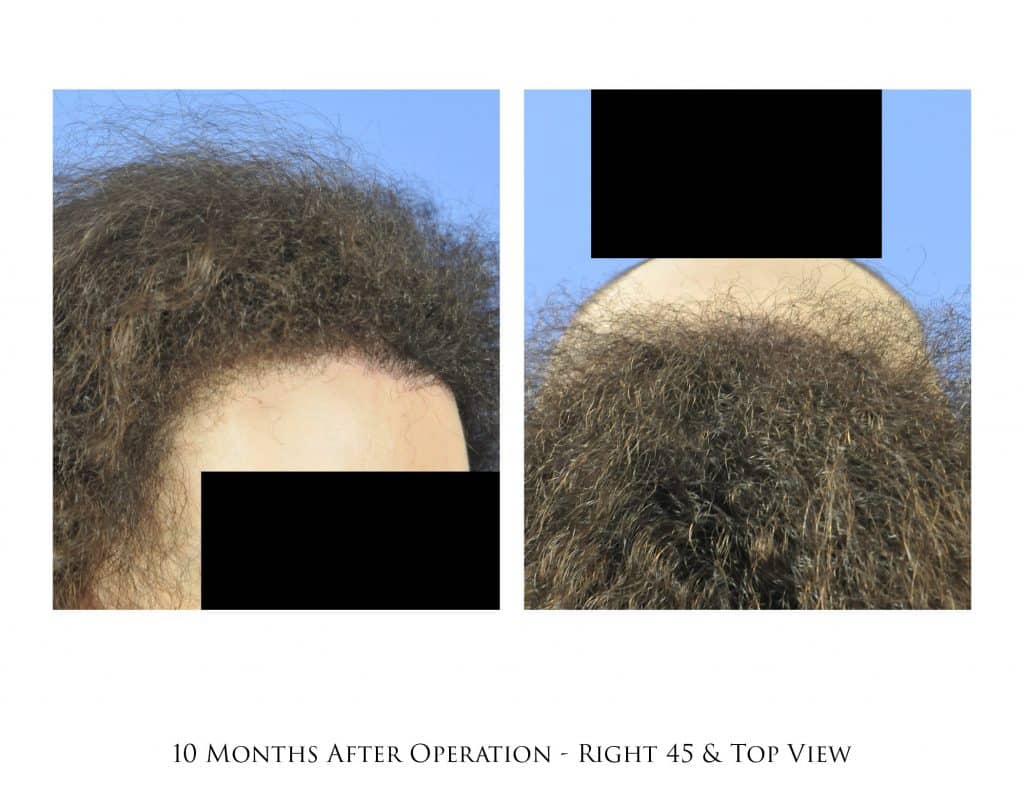Day 0: Day of hair transplant. The day starts early for Dr. Gabel and his patients. Depending upon the size and location of the transplant, the procedure can last from three hours to lasting throughout the day. When patients are finished, Dr. Gabel will review exactly how to care for the grafts until the following morning when the patient returns to have their transplants examined and their hair washed. Dr. Gabel will prescribe an antibiotic and pain medication to help with the postoperative recovery after the procedure.
Days 1 – 5: The first two weeks following a hair transplant are the most critical. Dr. Gabel provides his patients with detailed instructions on exactly how to care for the newly transplanted grafts. During the first five days, patients may experience swelling of the forehead and at the back of the head, which is the donor area. The skin may also look red in the areas where all the tiny incisions were made for the newly transplanted hairs. This redness usually resolves itself after the first week or two. After only a few days, the donor area is no longer tender.
Days 6 – 10: At this point, patients no longer experience any swelling, and the redness should only be faint or completely gone. For each follicular unit transplanted, a “crust” will form, which is the attached skin layer drying out. During this time, Dr. Gabel will have his patients gently remove the crusts by thoroughly soaking the grafts, and then gently rubbing them with a finger. By day 10, all the crusting should be gone and the transplanted hairs will appear like a “crew-cut” haircut. Lastly, around day 10, the sutures or staples will be removed.
Week 2 – 3: The transplanted hairs will start to shed at this point, and by the end of the third or fourth week most will be gone. This is a normal part of the healing process and is to be expected. The newly transplanted hairs go through a shedding process as the actual hair shaft is released, but the actual follicular unit and bulb are intact and will soon start to grow a new hair shaft. This is part of the normal hair cycle.
End of Month 1 – Month 2: The hair follicles have entered into the resting phase of their cycle. The length of the resting phase can vary before they start to grow again. At this stage, patients will appear exactly as they did prior to surgery with regards to the amount of hair present. Patients are also able to style and color their hair as they desire.
Months 2 – 4: The new hairs should start revealing themselves. For some patients, their transplanted hairs start growing early in the timeline; for others, they will start growing later. Patients will see the new transplanted hair, but they will be thin at this early stage as they first begin to emerge from the scalp. Most of the native hair will begin growing back at this time. The donor area will continue healing and any redness in the donor site will start to resolve itself.
Months 5 – 9: Patients will start to see a considerable amount of hair emerging from the scalp. The hairs will be thinner; many of the transplanted hairs will be over three inches or longer and capable of being groomed. Toward the end of this period, the hair will show textural changes and start to thicken up. At six months, Dr. Gabel will follow up with the patient to see how things are progressing. The donor area should be nearly completely healed by this point.
1 Year: Patients should yield about 80% of the growth from their transplanted hairs. Most of the hairs will have emerged from the scalp. Patients may notice that the hairs have a little “curvature” to them. This is from the micro-scarring that is at the recipient sites. This soon resolves itself and the hair takes on its native appearance over the next year.
2 Years: The final appearance from the hair transplant is appreciated at this point. For some patients, they achieve the full appearance by year one; others will take longer for the hairs to emerge and mature in density and thickness. Additionally, as the hair grows longer it will provide a fuller appearance since the volume of hair is increased within the transplanted areas.
Photographs to Illustrate Growth Timeline
To illustrate the actual growth, the patient below had a hair transplant on September 3, 2014, with Dr. Gabel at his Portland hair restoration office. The patient had significant hair loss in the frontal region of her hairline and frontotemporal angles. She desired to redefine her hairline and increase the hair density at the angles. The following series of photos shows the timeline of growth.





10 DAYS AFTER HAIR TRANSPLANT
Here are the 10 day suture removal photos from her hair transplant with Dr. Gabel. I tried to attach these to the original post, but I was not able to edit the original post.
As seen, the hairs are all growing, which indicates to me that the transplanted hairs are all viable. When patients come back for the suture/staple removal at 10 days, I point this out to them because in a short time, over the next three weeks, most of the transplanted hairs will fall out. Some patients become concerned about the hairs falling out, so I refer them to these photos that show all the transplanted hairs growing. Also at this time, there is a small amount of exudate or crusting that should be almost gone. All patients will develop some type of exudate, and it is important that they follow their physician’s postoperative instructions for proper care in the postoperative period.





2-MONTHS AFTER HAIR TRANSPLANT
These are the 2-month photographs of her progress. As shown, the transplanted hairs have all released and shed. This is normal and expected at this stage. The hairs that are transplanted go through a temporary “shock” period where the actual hair shaft is released. The hair now starts growing a new hair shaft and we will start seeing that in the next few months.


3-MONTHS AFTER HAIR TRANSPLANT
These are the 3-month postoperative photographs showing that the hairs are now starting to grow in. This patient had 3,439 follicular unit grafts transplanted at our Portland hair transplant center. Her hair is matted down as she was wearing a hat all day long prior to coming into the office for her photographs. The hair is just stating to come out, and as expected, it is thin and sparse. This should change over the next few months as more of the hairs start to grow, and the hair shafts begin to thicken.

















